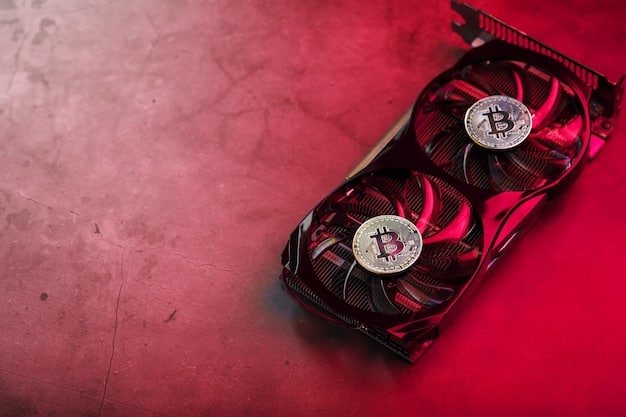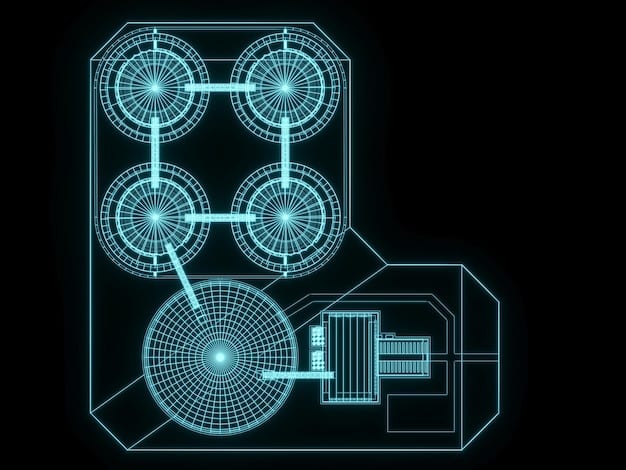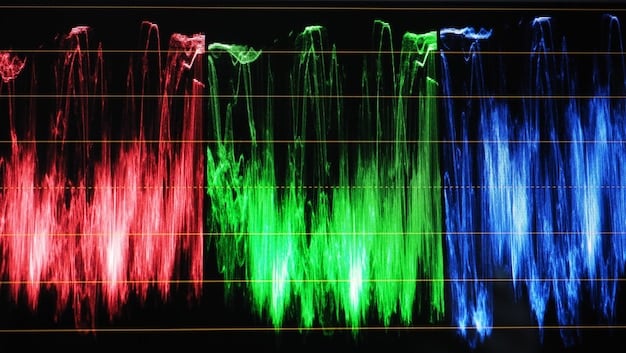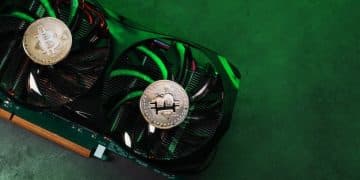AMD RX 8000: Ray Tracing Leaks and Performance Insights

AMD Radeon RX 8000 Series leaks hint at significant ray tracing performance enhancements, potentially closing the gap with competitors and offering gamers a more immersive visual experience.
The rumor mill is churning, and early whispers surrounding the AMD Radeon RX 8000 Series: What Leaks Reveal About Ray Tracing Performance Improvements in the Next 6 Months are creating quite a buzz. Will AMD’s next-generation graphics cards finally deliver a knockout blow in the ray tracing arena? Let’s dive into the latest leaks and speculate on what the future holds for AMD’s ray tracing capabilities.
AMD Radeon RX 8000 Series: Ray Tracing Expectations
The AMD Radeon RX 8000 series is highly anticipated, with gamers and enthusiasts eager to see how AMD addresses the persistent performance gap in ray tracing compared to its competitors. Ray tracing performance has been a key area of focus for both AMD and Nvidia, and the RX 8000 series could be a pivotal moment for team red.
Architectural Improvements and Ray Tracing Cores
One of the most significant areas of speculation revolves around the architectural improvements that AMD might implement in the RX 8000 series. Rumors suggest that AMD could be introducing enhanced ray tracing cores, similar to what Nvidia has done with its RTX series. These dedicated cores would handle the computationally intensive ray tracing tasks, freeing up the main processing units for other rendering operations.
Software Optimizations for Enhanced Ray Tracing
Beyond hardware, software optimizations play a critical role in ray tracing performance. AMD has been actively working on improving its FidelityFX suite of technologies, including FidelityFX Super Resolution (FSR), which can significantly boost frame rates in ray tracing-enabled games. The RX 8000 series is expected to benefit from further refinements to FSR and other software-based ray tracing enhancements.
- Hardware Upgrades: Enhanced ray tracing cores for faster calculations.
- Software Tweaks: Refined FidelityFX Super Resolution (FSR) technology.
- DirectX Raytracing (DXR) Support: Improved implementation for better performance.
- Hybrid Rendering Techniques: Combining traditional and ray-traced rendering for efficiency.
In summary, if rumors turn out to be true, the AMD Radeon RX 8000 Series: What Leaks Reveal About Ray Tracing Performance Improvements in the Next 6 Months may feature improved architecture and better optimized ray tracing cores to enhance ray tracing performance in gaming.
Leaked Specifications and Performance Projections
While official specifications remain tightly guarded, several leaks and rumors have provided potential glimpses into the RX 8000 series’ performance. These leaks should be taken with a grain of salt, as they are often based on unconfirmed information, but they offer valuable insights into what AMD might be targeting.
Core Count and Clock Speeds
Leaks suggest that the RX 8000 series could see a significant increase in core counts compared to the RX 7000 series. More cores generally translate to greater processing power, which can directly impact ray tracing performance. Additionally, higher clock speeds could also contribute to faster ray-traced rendering.
Memory Configuration and Bandwidth
Memory bandwidth is another crucial factor in ray tracing performance. Leaks indicate that the RX 8000 series might feature a faster memory interface, potentially using GDDR7 memory, which would provide a substantial boost in bandwidth. This increased bandwidth would allow the graphics card to handle the large amounts of data associated with ray tracing more efficiently.

- Increased Core Count: More processing power for ray tracing calculations.
- Higher Clock Speeds: Faster overall rendering performance.
- GDDR7 Memory: Enhanced memory bandwidth for handling large datasets.
- Improved Memory Interface: Efficient data transfer between GPU and memory.
Ultimately, the leaks regarding the AMD Radeon RX 8000 Series: What Leaks Reveal About Ray Tracing Performance Improvements in the Next 6 Months point toward a card that is both faster and more capable than previous generations, but confirmation will require official announcements.
Ray Tracing Benchmarks and Comparisons
One of the most anticipated aspects of the RX 8000 series is how it will perform in real-world ray tracing benchmarks. Comparing leaked or projected performance numbers with existing cards from both AMD and Nvidia can provide a better understanding of the potential improvements.
3DMark Port Royal and DXR Benchmarks
3DMark Port Royal is a popular benchmark specifically designed to test ray tracing performance. Leaked scores for the RX 8000 series in Port Royal, if accurate, could offer a direct comparison to current-generation cards. Similarly, other DXR (DirectX Raytracing) benchmarks could provide further insights into AMD’s ray tracing capabilities.
Game-Specific Ray Tracing Performance
While synthetic benchmarks offer a standardized way to measure performance, game-specific benchmarks provide a more realistic view of how the RX 8000 series will perform in actual games. Games like Cyberpunk 2077, Control, and Metro Exodus Enhanced Edition are known for their demanding ray tracing implementations, making them excellent test cases for evaluating ray tracing performance.
In conclusion, we expect the AMD Radeon RX 8000 Series: What Leaks Reveal About Ray Tracing Performance Improvements in the Next 6 Months to display competitive performance in the latest benchmarking software once released.
Analyzing the Competition: Nvidia’s RTX Series
To fully appreciate the potential impact of the RX 8000 series, it’s essential to consider the competition, namely Nvidia’s RTX series. Nvidia has been a leader in ray tracing technology, and their RTX cards have consistently delivered impressive ray tracing performance. Understanding Nvidia’s strengths and weaknesses can provide valuable context for evaluating AMD’s progress.
Nvidia’s Ray Tracing Advantages
Nvidia’s RTX cards benefit from dedicated ray tracing hardware, known as RT cores, which accelerate the ray tracing process. Additionally, Nvidia has invested heavily in software optimizations, such as DLSS (Deep Learning Super Sampling), which can significantly improve performance in ray tracing-enabled games. DLSS uses AI to upscale lower-resolution images, reducing the computational burden on the GPU.
Potential Areas of Improvement for AMD
While Nvidia holds a lead in ray tracing performance, AMD has several opportunities to catch up. By improving its hardware architecture, optimizing its software, and developing its own upscaling technologies, AMD can close the performance gap. The RX 8000 series represents a critical step in this direction.

- Dedicated RT Cores: Specialized hardware for ray tracing acceleration.
- DLSS Technology: AI-powered upscaling for improved performance.
- Software Optimizations: Continuous refinements to ray tracing algorithms.
- Strong Ecosystem: Wide support from game developers and software vendors.
Regardless of where the market leads, the AMD Radeon RX 8000 Series: What Leaks Reveal About Ray Tracing Performance Improvements in the Next 6 Months promises to be hot competition for Nvidia’s RTX series.
Impact on Gaming and Content Creation
The potential ray tracing improvements in the RX 8000 series could have a significant impact on both gaming and content creation. Ray tracing enhances the visual fidelity of games by simulating realistic lighting, reflections, and shadows. In content creation, ray tracing can accelerate rendering times, allowing artists and designers to create more complex and visually stunning projects.
Enhanced Visual Fidelity in Gaming
With improved ray tracing performance, gamers can expect more immersive and visually impressive gaming experiences. Realistic lighting and reflections can add a new level of realism to games, making them feel more lifelike and engaging.
Accelerated Rendering in Content Creation
Content creators can also benefit from the RX 8000 series’ ray tracing capabilities. Faster rendering times can significantly speed up the content creation workflow, allowing artists and designers to iterate more quickly and create higher-quality content. Ray tracing can enhance the realism and detail of rendered images and videos, making them more professional and visually appealing.
In short, the improvements to the AMD Radeon RX 8000 Series: What Leaks Reveal About Ray Tracing Performance Improvements in the Next 6 Months can greatly improve the experience of both gamers and content creators alike thanks to the use of advanced technology.
The Future of AMD’s Ray Tracing Technology
The RX 8000 series represents a significant step in AMD’s ray tracing journey, but it’s just the beginning. AMD is likely to continue investing in ray tracing technology, both in terms of hardware and software, to further improve its performance and capabilities. The future of AMD’s ray tracing technology looks promising, with the potential for even more significant advancements in the years to come.
Long-Term Roadmap for Ray Tracing
AMD likely has a long-term roadmap for ray tracing, which includes not only hardware improvements but also software optimizations and new features. Future generations of AMD graphics cards could feature even more advanced ray tracing cores, as well as new technologies for enhancing ray tracing performance and visual quality.
Collaboration with Game Developers
Collaboration with game developers is crucial for the success of ray tracing. AMD is likely to continue working closely with game developers to ensure that its ray tracing technology is well-integrated into games and that developers can take full advantage of its capabilities. These collaborations could lead to new and innovative ways to use ray tracing in games.
| Key Point | Brief Description |
|---|---|
| 🚀 Ray Tracing Boost | Significant ray tracing performance improvements in the RX 8000 series. |
| ⚙️ Architectural Leaks | Rumors about architectural upgrades to enhance ray tracing. |
| 🎮 Gaming Impact | More immersive gaming experiences with ray-traced visuals. |
| 🏆 Competition | AMD aiming to compete strongly with Nvidia in ray tracing. |
Frequently Asked Questions (FAQ)
▼
Ray tracing is an advanced rendering technique that simulates realistic lighting and reflections in games and other visual applications. It’s important because it significantly enhances the visual fidelity and immersion of the experience.
▼
Leaks suggest potential architectural enhancements and software optimizations aimed at boosting ray tracing performance. This would mean faster rendering and smoother frame rates when ray tracing is enabled.
▼
Nvidia has traditionally led in ray tracing performance, but AMD is working to close the gap. The RX 8000 series could narrow the performance difference, offering more competitive ray tracing capabilities.
▼
Improved ray tracing performance means more visually stunning and immersive gaming experiences. Gamers can expect enhanced lighting, reflections, and shadows, bringing games to life like never before.
▼
Yes, content creators can also benefit from the RX 8000 series’ ray tracing capabilities. Faster rendering times can significantly speed up content creation workflows, allowing for more complex and visually appealing projects.
Conclusion
In conclusion, the emerging leaks surrounding the AMD Radeon RX 8000 Series: What Leaks Reveal About Ray Tracing Performance Improvements in the Next 6 Months suggest that AMD is ready to make a significant leap forward in ray tracing performance. Should the RX 8000 series deliver on these leaks, the next generation is set to alter the competition from Nvidia in the graphics card market, and offer gamers and content creators richer, more immersive experiences.

